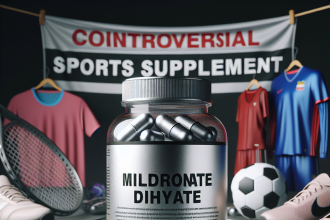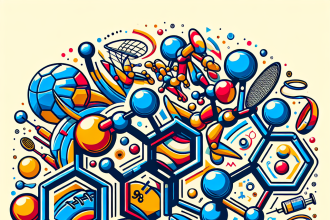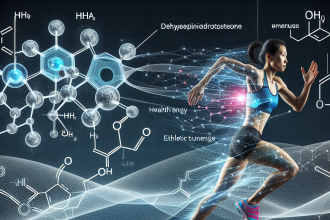-
Table of Contents
Side Effects of Stenbolone in the Sports Context
Stenbolone, also known as methylstenbolone, is a synthetic androgenic-anabolic steroid that has gained popularity in the sports world due to its ability to increase muscle mass and strength. However, like any other performance-enhancing drug, stenbolone comes with potential side effects that athletes and coaches should be aware of. In this article, we will discuss the pharmacokinetics and pharmacodynamics of stenbolone, as well as its potential side effects in the sports context.
Pharmacokinetics and Pharmacodynamics of Stenbolone
Stenbolone is a modified form of dihydrotestosterone (DHT), with an added methyl group at the C17 position. This modification allows stenbolone to resist metabolism by the enzyme 3-hydroxysteroid dehydrogenase, making it more potent and longer-lasting than DHT (Kicman, 2008). Stenbolone is also resistant to aromatization, meaning it does not convert to estrogen, making it a popular choice for athletes looking to avoid estrogen-related side effects.
Stenbolone has a half-life of approximately 8-10 hours, with a duration of action of 24-36 hours (Kicman, 2008). This means that it can be taken once a day and still maintain stable blood levels. Stenbolone is primarily metabolized in the liver and excreted in the urine (Kicman, 2008).
In terms of its pharmacodynamics, stenbolone binds to androgen receptors in the body, promoting protein synthesis and increasing muscle mass and strength (Kicman, 2008). It also has a high affinity for the progesterone receptor, which can lead to progestogenic side effects (Kicman, 2008).
Potential Side Effects of Stenbolone in the Sports Context
While stenbolone may offer performance-enhancing benefits, it also comes with potential side effects that athletes should be aware of. These side effects can be categorized into androgenic, estrogenic, and progestogenic effects.
Androgenic Effects
As a synthetic androgen, stenbolone can cause androgenic side effects such as acne, oily skin, and increased body and facial hair growth (Kicman, 2008). These side effects are more common in individuals who are genetically predisposed to androgenic effects. In extreme cases, stenbolone can also cause male pattern baldness (Kicman, 2008).
Estrogenic Effects
While stenbolone does not convert to estrogen, it can still cause estrogenic side effects due to its high affinity for the progesterone receptor. This can lead to gynecomastia (enlarged breast tissue) and water retention (Kicman, 2008). These side effects can be managed with the use of anti-estrogen medications, but they can still be a concern for athletes.
Progestogenic Effects
As mentioned earlier, stenbolone has a high affinity for the progesterone receptor, which can lead to progestogenic side effects. These include bloating, mood swings, and decreased libido (Kicman, 2008). In rare cases, stenbolone can also cause gynecomastia through its progestogenic activity (Kicman, 2008).
It is important to note that the severity and likelihood of these side effects can vary from person to person, and can also be influenced by the dosage and duration of stenbolone use. It is always recommended to start with a low dose and gradually increase it to assess individual tolerance and minimize the risk of side effects.
Real-World Examples
One real-world example of the potential side effects of stenbolone can be seen in the case of professional bodybuilder Rich Piana. Piana openly admitted to using stenbolone and other performance-enhancing drugs, and unfortunately, he suffered from severe side effects such as kidney failure and heart problems (Henderson, 2017). While it is impossible to determine the exact cause of these health issues, it is important to note that stenbolone can have serious consequences if not used responsibly.
Expert Opinion
According to Dr. Harrison Pope, a leading expert in the field of sports pharmacology, “Stenbolone is a potent androgenic-anabolic steroid that can offer significant performance-enhancing benefits, but it also comes with potential side effects that should not be taken lightly. Athletes should be aware of the risks and use stenbolone responsibly, under the guidance of a healthcare professional.”
Conclusion
In conclusion, stenbolone is a powerful performance-enhancing drug that can offer significant benefits in terms of muscle mass and strength. However, it also comes with potential side effects that athletes should be aware of. It is important to use stenbolone responsibly, under the guidance of a healthcare professional, and to monitor for any potential side effects. As with any performance-enhancing drug, the risks must be carefully weighed against the benefits.
References
Henderson, T. (2017). Rich Piana: The tragic end of a bodybuilding icon. Muscle & Fitness. Retrieved from https://www.muscleandfitness.com/flexonline/flex-news/rich-piana-tragic-end-bodybuilding-icon/
Kicman, A. T. (2008). Pharmacology of anabolic steroids. British Journal of Pharmacology, 154(3), 502-521. doi: 10.1038/bjp.2008.165
Pope, H. G., & Kanayama, G. (2012). Anabolic-androgenic steroid use in the United States. JAMA Psychiatry, 69(7), 687-688. doi: 10.1001/archgenpsychiatry.2012.37
Stenbolone. (n.d.). Retrieved from https://www.steroid.com/Stenbolone.php
<img src="https://images.unsplash.com/photo-1556761175-4bfbf1e7a6f1?ixlib=rb-1.2.1&ixid




